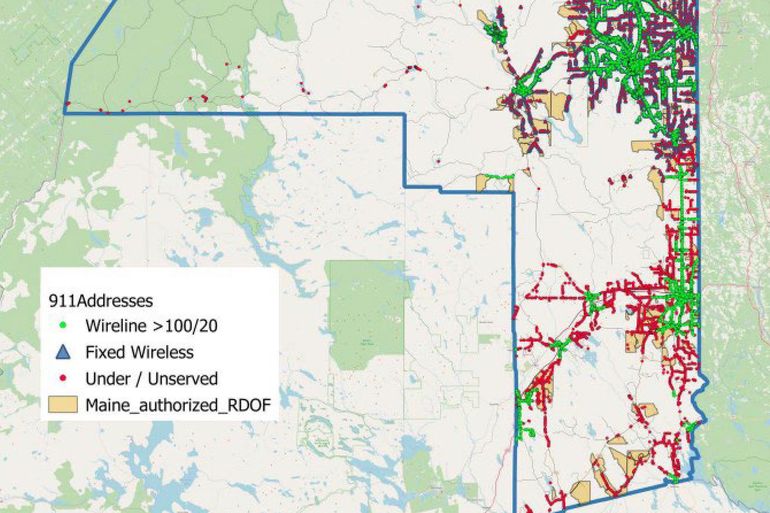
Maine's plan for closing the digital divide could mean millions in federal funding
 Courtesy / County Broadband Committee
The red blocks indicate Aroostook County areas that are underserved and unserved by quality broadband.
Courtesy / County Broadband Committee
The red blocks indicate Aroostook County areas that are underserved and unserved by quality broadband.
Maine is now the first state to win federal approval of a plan for expanding high-speed internet access, and the OK could mean $14 million to do so.
The state's digital equity plan was approved by the National Telecommunications and Information Administration, according to a news release. The administration is an agency of the U.S. Department of Commerce.
The plan outlines steps the state will take to expand access to high-speed, reliable internet and to break down barriers to connections, especially for populations most impacted by the digital divide.
Plan approval is the first step for Maine to qualify for Digital Equity Act funding from the federal government, with an estimated allocation between $12 million and $14 million. The allocations and details will be released by NTIA later this spring.
The goal is to ensure that everyone in Maine can access the internet.
“While expanding infrastructure is important, it’s only part of the solution,” said Andrew Butcher, president of the Maine Connectivity Authority. “To make sure everyone is truly connected, service must be affordable, and Maine people must have the confidence and tools to connect.”

The Maine Connectivity Authority, a quasi-governmental agency, was created in 2021 to achieve universal access to affordable broadband in Maine.
For the recently completed plan, the authority says it identified key challenges to closing the digital divide, including a focus on the affordability of service, access to internet-capable devices, digital skills and online safety training.
The plan includes strategies to reduce barriers to connectivity for those most underserved, including older adults, veterans, low-income families, people living in rural areas, people with disabilities and minority populations.
It also describes partnerships and goals for private investments to maximize funds.
Strategies include:
- Improve access to broadband through grant funding for local and regional infrastructure projects;
- Establish the Maine Digital Equity Fund, which will raise $15 million in philanthropic support and be matched by additional investment from the federal government.
- Increase affordability of internet service and expand access to free or low-cost connectivity in affordable housing units;
- Secure at least 25,000 donated devices for refurbishment from businesses, institutions and agencies statewide;
- Ensure access to affordable devices (desktops, laptops, tablets) and technical support by distributing 50,000 new and refurbished devices to Mainers who need them;
- Improve Mainers’ digital skills through outreach and training;
- Help Mainers stay safe online by providing internet safety training;
- Make it easier to access government resources and programs online.
“That Maine is the first state in the nation to earn the approval of its Digital Equity Plan demonstrates the seriousness of our commitment to closing the digital divide and delivering affordable, high-speed internet to anyone in Maine who wants it,” said Gov. Janet Mills. “We look forward to seeking every available federal dollar to help us achieve that because we know expanding internet access is a necessity for the success of our people and our economy.”
Internet input
Development of the plan was funded by $542,222 from the Digital Equity Act’s State Digital Equity Planning Grant Program.
To create the plan, the authority and its partners conducted six months of outreach and engagement in 2023. Six stakeholder groups comprising 117 individuals, organizations and agencies contributed to the process. Additionally, three formal tribal consultations were held with the chiefs of the Mi’kmaq Nation, the Passamaquoddy Tribe at Sipayik and the Passamaquoddy Tribe at Motahkomikuk.
The statewide Maine Broadband Survey collected over 3,200 responses online and in hard-copy versions and was translated into 12 languages. Thirteen focus groups were facilitated by the authority and hosted by organizations that serve or represent the priority populations. An additional 16 community meetings were held around the state to collect feedback from the general public.
Thirteen regional and tribal broadband partners convened 180 digital equity coalition partners, conducted 651 interviews and created a digital equity plan for each region and tribal community. The authority and its partners also hosted a workshop facilitated by the National Digital Inclusion Alliance, bringing together 120 participants and concluding the planning period.
“High-speed internet is not a luxury,” said Noël Bonam, state director for AARP Maine, which has 200,000 members. “It is a necessity for older Mainers.”
To see the plan, click here.













0 Comments